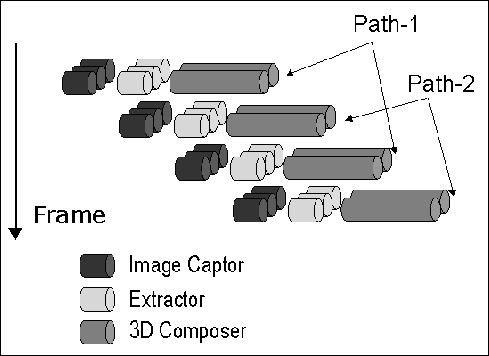Contents of this page are obsolete.
This page is preserved and stored at this URL just from historical viewpoint.
Original URL was http://www.mm.media.kyoto-u.ac.jp/members/kameda/...
Please visit
www.kameda-lab.org
for recent information. (2002/12/06, [email protected])
Publication,
Research,
Docs and Info,
KAMEDA



Next: Experiment
Up: 3D Reconstruction Method
Previous: 3D Reconstruction
Our 3D reconstruction system named SCRAPER can be divided into three
stages.
- image capture
- extraction of dynamic region
- ESS calculation by VFM method
Let us call this sequence of stages a path.
If the 3D reconstruction is done in this order sequentially,
some parts of the system always idle. For example, when images are
being captured, extraction and ESS calculation cannot be done.
As a result, throughput is low and that is not desirable for
real-time VR applications.
To improve the throughput, we propose to activate several paths
simultaneously in the pipeline architecture.
We prepare three kinds of processes: image captor,
extractor, and 3D composer and increase number of these
processes to support multiple paths.
In our prototype system, an image is captured by the video capture
card for which CPU power is not necessary whereas an extractor needs
CPU power because it extracts  by detecting regions where
the pixel values differ from its background image taken beforehand, so
the two processes need only one CPU to work together. In addition,
captured image data which is transferred to the extractor is not small
and so it is not desirable to use physical network device to transmit
the data between them. Therefore, We assign one video image captor and
one extractor on the same workstation. As a result, the number of
video image captors and that of the extractors are the same as that of
the cameras.
by detecting regions where
the pixel values differ from its background image taken beforehand, so
the two processes need only one CPU to work together. In addition,
captured image data which is transferred to the extractor is not small
and so it is not desirable to use physical network device to transmit
the data between them. Therefore, We assign one video image captor and
one extractor on the same workstation. As a result, the number of
video image captors and that of the extractors are the same as that of
the cameras.
On the contrary, the number of 3D composers can be increased because
the calculation on the 3D composer is completely localized. The system
can improve the throughput by preparing the 3D composers on different
workstations distributed in a LAN.
As a consequence, the throughput is improved by preparing the multiple
paths in the pipeline architecture, which means temporal division of
3D reconstruction process. The number of the paths are subjected to
the number of the 3D composers the system can offer. Figure
1 shows the process timing chart when the system has
four cameras and four 3D composers and assigns two 3D composers at each
path.
We introduce a process named scheduler to synchronize the
processes in the pipeline architecture.

Figure 1: Pipeline Architecture



Next: Experiment
Up: 3D Reconstruction Method
Previous: 3D Reconstruction
Yoshinari Kameda
Mon Sep 21 11:42:41 JST 1998
 by detecting regions where
the pixel values differ from its background image taken beforehand, so
the two processes need only one CPU to work together. In addition,
captured image data which is transferred to the extractor is not small
and so it is not desirable to use physical network device to transmit
the data between them. Therefore, We assign one video image captor and
one extractor on the same workstation. As a result, the number of
video image captors and that of the extractors are the same as that of
the cameras.
by detecting regions where
the pixel values differ from its background image taken beforehand, so
the two processes need only one CPU to work together. In addition,
captured image data which is transferred to the extractor is not small
and so it is not desirable to use physical network device to transmit
the data between them. Therefore, We assign one video image captor and
one extractor on the same workstation. As a result, the number of
video image captors and that of the extractors are the same as that of
the cameras.
